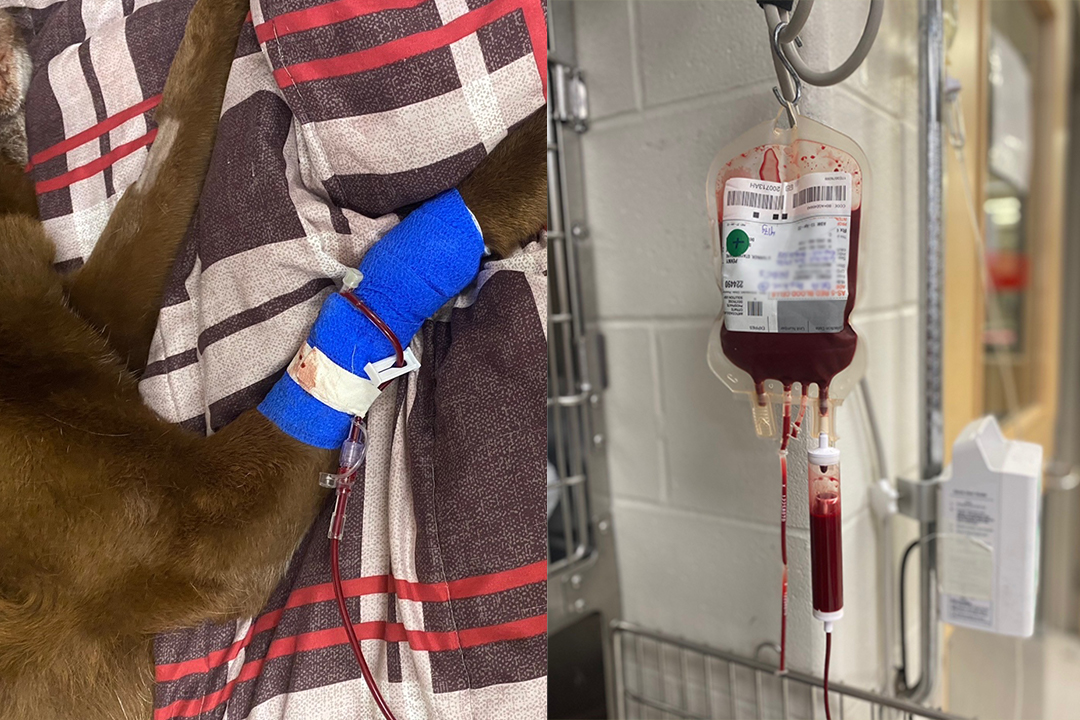
Blood on the double
Dogs can donate life-saving blood to other dogs, just like people can give blood to their fellow humans. But veterinarians are still unsure about the best way to deliver blood from dog donors to the canine patients that urgently need it.
By Madlyn LungThat’s why I’m working with my supervisor, Dr. Jen Loewen, to find a more efficient way to conduct blood transfusions in dogs. I’m a fourth-year veterinary student at the Western College of Veterinary Medicine (WCVM) while she’s an emergency and critical care specialist at the veterinary college.
Red blood cells are vital as they deliver oxygen throughout the body. Dogs may require more red blood cells (RBCs) if they bleed a lot, if their body attacks and destroys their own red blood cells, or if their body can no longer make enough of them — if any. In cases like these, dogs need a blood transfusion.
In a veterinary clinic, a blood transfusion usually involves a donor dog’s blood in a blood bag travelling through a clear filter chamber so a clinical team member can count the drips. The blood is filtered, then goes through the tubing and into the bloodstream of the dog that needs blood.
Using the gravity drip system to give a blood transfusion to a dog takes a lot of time — mainly because someone must watch and count each blood drip coming through the line.
“You can’t set them properly and it removes technicians from patient care. It often takes you a full 15 minutes to set the drops right,” says Kendall Bueckert, a registered veterinary technologist (RVT) who has worked in the veterinary intensive care unit (ICU) for 11 years.
It’s also difficult to convince dogs to sit still enough to allow the counting drips method to be consistent. Another complication is the patient’s size: in very small patients, the required drip rate is very slow — making it even harder to achieve a consistent rate.
“Using gravity and drip rates sounds simple in theory,” says Loewen. “But when the dog receiving the transfusion is moving its leg or shifting its position from standing to sitting down or vice versa, the rate of the transfusion can easily speed up or stop completely. And unless it is being watched constantly, it might go unnoticed.”
This method is based on previous research suggesting that the speed at which we give a blood transfusion is better determined by counting blood drips rather than using a fluid pump machine. Clinical staff regularly use this device for delivering water and electrolytes to rehydrate patients.
Fluid pump machines allow the clinical team to more accurately deliver the transfusion and spend more time providing high quality veterinary care. But in previous research, scientists found that using a fluid pump machine may damage the red blood cells and cause them not to survive as long in the patient receiving the transfusion.
Those results surprised Loewen, who has previously used fluid pump machines to deliver blood transfusions to her canine patients.
“When discussing this with other researchers on campus, a different red blood cell marker was suggested, and [that’s when] this project started to take form,” says Loewen.
In our study, we’re testing the different methods of administering a blood transfusion in dogs using a new cell label called PKH26. This red fluorescent dye can be used for long-term tracking of cells in vivo (inside the body). We’re using it to trail the red blood cells that we transfused into the dogs several days after the transfusion took place.
This new cell label makes the red blood cells glow when observed using a special microscope, allowing us to find them later so we can see how long these cells survive in the dog. The higher the percentage of glowing cells that we find in the dog’s bloodstream, the higher the number of red blood cells that survived the transfusion process.
So far, we have found that this new label works with canine blood cells and can be used to measure red blood cells’ survival rate in dogs given a transfusion with a gravity drip system in the short term. While that aspect of the research study went well, the process of maintaining a consistent drip rate during blood transfusions was a struggle — even though we were working with well behaved, healthy dogs.
The gravity drip system requires you to perfectly balance a small rolling clamp to achieve the correct drip rate coming out of the bag. But realistically, it’s never exact. The weight of the blood, which forces the drips out into the chamber, changes during the transfusion as the volume of blood in the bag decreases.
The moment you turn your back, the drips slow down, speed up or stop entirely — forcing you to go back and frequently readjust the roller. During the 90-minute blood transfusions, we constantly shuffled from dog to dog to correct the rates and to readjust the rolling clamps.
In the project’s next phase, we will use the cell label PKH26 to compare two types of blood transfusion delivery: the first with a syringe driver (blood pushed into the line through a syringe), and the second with a fluid pump machine.
Once we analyze our results, we can determine whether the previous research favouring gravity drip systems is still accurate or whether fluid pumps prove to be more effective for transfusing healthy, functioning red blood cells.
“Being able to use pumps to provide life-saving transfusions rather than counting drips would allow the individuals working with these patients to devote more time focusing on the patient rather than the transfusion method,” says Loewen.
The WCVM’s Companion Animal Health Fund provided funding for this research project.
Madlyn Lung of Edmonton, Alta., is a fourth-year veterinary student at the Western College of Veterinary Medicine (WCVM) who worked as a summer research student in 2021. Her story is part of a series of articles written by WCVM summer research students.
